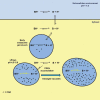Antiviral activity of cationic amphiphilic drugs
- PMID: 28286997
- PMCID: PMC7103695
- DOI: 10.1080/14787210.2017.1305888
Antiviral activity of cationic amphiphilic drugs
Abstract
Emerging and reemerging viral infections represent a major concern for human and veterinary public health and there is an urgent need for the development of broad-spectrum antivirals. Areas covered: A recent strategy in antiviral research is based on the identification of molecules targeting host functions required for infection of multiple viruses. A number of FDA-approved drugs used to treat several human diseases are cationic amphiphilic drugs (CADs) that have the ability to accumulate inside cells affecting several structures/functions hijacked by viruses during infection. In this review we summarized the CADs' chemical properties and effects on the cells and reported the main FDA-approved CADs that have been identified so far as potential antivirals in drug repurposing studies. Expert commentary: Although there have been concerns regarding the efficacy and the possible side effects of the off-label use of CADs as antivirals, they seem to represent a promising starting point for the development of broad-spectrum antiviral strategies. Further knowledge about their mechanism of action is required to improve their antiviral activity and to reduce the risk of side effects.
Keywords: Amiodarone; Crimean–Congo hemorrhagic fever virus; Herpes simplex virus; U18666A; Zika virus; antivirals; cationic amphiphilic drugs; chikungunya virus; chloroquine; dengue virus; ebola virus; emerging viruses; enterovirus; hepatitis C virus; ion channel blockers; protein kinase inhibitors; psychoactive drug; selective estrogen receptor modulators.
Figures

References
-
- Calistri A, Salata C, Parolin C, et al. New generation sequencing in pathogen discovery and microbial surveillance. Expert Rev Anti Infect Ther. 2013;11(9):877–879. - PubMed
-
- Fineberg HV. Pandemic preparedness and response–lessons from the H1N1 influenza of 2009. N Engl J Med. 2014;370(14):1335–1342. - PubMed
-
- Abushouk AI, Negida A, Ahmed H.. An updated review of Zika virus. J Clin Virol. 2016;84:53–58. - PubMed
Publication types
MeSH terms
Substances
LinkOut - more resources
Full Text Sources
Other Literature Sources
Medical
